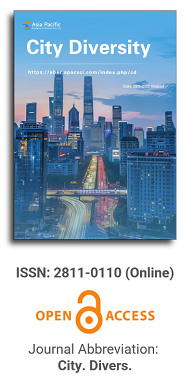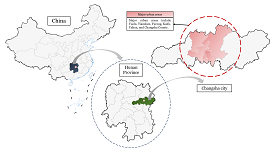
Asia Pacific Academy of Science Pte. Ltd. (APACSCI) specializes in international journal publishing. APACSCI adopts the open access publishing model and provides an important communication bridge for academic groups whose interest fields include engineering, technology, medicine, computer, mathematics, agriculture and forestry, and environment.

As China's pillar industry, the property market has suffered a considerable impact in recent years, with a decline in turnover and many developers at risk of bankruptcy. As one of the most concerned factors for stakeholders, housing prices need to be predicted more objectively and accurately to minimize decision-making errors by developers and consumers. Many prediction models in recent years have been unfriendly to consumers due to technical difficulties, high data demand, and varying factors affecting house prices in different regions. A uniform model across the country cannot capture local differences accurately, so this study compares and analyses the fitting effects of multiple machine learning models using February 2024 new building data in Changsha as an example, aiming to provide consumers with a simple and practical reference for prediction methods. The modeling exploration applies several regression techniques based on machine learning algorithms, such as Stepwise regression, Robust regression, Lasso regression, Ridge regression, Ordinary Least Squares (OLS) regression, Extreme Gradient Boosted regression (XGBoost), and Random Forest (RF) regression. These algorithms are used to construct forecasting models, and the best-performing model is selected by conducting a comparative analysis of the forecasting errors obtained between these models. The research found that machine learning is a practical approach to property price prediction, with least squares regression and Lasso regression providing relatively more convincing results.
The protection planning of small and micro habitats in urban fringe areas: Enlightenment from the management of high natural value farmland in the EU to the maintenance of bio-diversity in urban areas in China
Vol 5, Issue 1, 2024
Download PDF
Abstract
The habitat unit in urban fringe is an important link to support regional biodiversity; due to the influence of urban system and agricultural system, most of them are semi natural, appeared with diverse types, small patches, scattered layout, and generally relying on low intensity farming activities. Export-oriented expansion of urban construction land and intensive agricultural production are prone to reduce the scale and quality of semi natural habitats in urban fringe areas; and the existing measures cannot effectively protect them. High natural value farmland management is an effective measure of the EU to protect semi-natural habitats related to agriculture and maintain regional biodiversity. Through combing the main points of high natural value farmland such as type definition, evaluation, identification, maintenance management, etc., this paper proposes the suggestions for optimization of small and micro semi-natural habitat protection in China: (1) strengthening the recognition of the value of small and microhabitats and related land use; (2) identifying small and micro-habitats that are conducive to the maintenance of biodiversity, and incorporating them in the overall protection of regional network; (3) combining the rigidity and flexibility of land use control, with the consideration of complex function demands; (4) Converging with the existing statutory planning to enhance the protection efficiency of small and micro habitats.
Keywords
References
- Shi Y. Research on the landscape approach of sponge city based on biodiversity. Zhonghua Construction. 2019; (11): 80–81.
- Liu G, Xiao N, Gao X, et al. Effects of different urbanization gradients on plant communities in Beijing's green space. Grass Industry Science. 2019; 36(1): 69–82.
- You H, Tang H, Zhang B, et al. Spatial distribution characteristics of species richness in urban road green space in Xuzhou. Green Science and Technology. 2018; (24): 118–122.
- Peng Y, Liu X. Research progress on the impact of urbanization on plant diversity. Biodiversity. 2007; (5): 558–562.
- Feng Q, Hao P, Dong L, et al. Research on biodiversity characteristics and indicators of urban wetland parks based on habitats. Landscape Architecture. 2019; 26(1): 37–41.
- Chen J, Ji D, Xiao Y, et al. Micro-renewal exploration of urban idle land from the perspective of biodiversity: Taking temporary community gardens as an example. Chinese Garden. 2019; 35(12): 28–33.
- Han Y, Li Y, Li F. The influence of urban green space landscape pattern on the quality of "core habitat". Landscape Architecture. 2020; 27(2): 83–87.
- Yin H, Kong F, Qi Y, et al. Construction and optimization of ecological network of urban agglomerations in Hunan Province. Journal of Ecology. 2011; 31(10): 2863–2874.
- Zerbe S, Maurer U, Schmitz S, et al. Biodiversity in Berlin and its potential for nature conservation. Landscape and urban planning. 2003; 62(3): 139-148. https://doi.org/10.1016/S0169-2046(02)00145-7
- Li J, Gao J, Zhang X, et al. A review of studies on the impact of urbanization on biodiversity. Journal of Ecology. 2005; (8): 953–957.
- Kong F, Yin H. Construction of Jinan Urban Green Space Ecological Network. Journal of Ecology. 2008; (4): 1711–1719.
- Mei H. On my country's Ecological Protection Legislation and Its Improvement. Journal of Ocean University of China (Social Science Edition). 2008; (5): 49–55.
- Xue D, Xu H. The current situation and needs of China's biodiversity conservation legislation. Rural Ecological Environment. 1996; (4): 37–41.
- Chen H, Huang M. The establishment and improvement of the legal protection system of biodiversity in my country. Anhui Agricultural Sciences. 2005; (2): 358–360.
- Huang B, Ma Y, Huang K, et al. Thoughts on Promoting the Reform of the Natural Reserve System with National Parks as the Main Body. Proceedings of the Chinese Academy of Sciences. 2018; 33(12): 1342–1351.
- He W, Jin X, Hu X. Development and Enlightenment of Habitat Network Planning in Germany. Journal of Central South University of Forestry and Technology. 2011; (7): 190–194, 208.
- Zhou X, Zheng D. Evaluation of Ecological Security Pattern in Wuhan Urban Circle. Urban Planning. 2018; 42(12): 132–140.
- Yu K, Li D, Liu H, et al. Urban Spatial Development Pattern Based on Ecological Infrastructure-Taizhou Case of "Anti-planning". Urban Planning. 2005; (9): 76–80, 97–98.
- Li H, Wang Y. Research on the Legal Protection of Agricultural Biodiversity in the European Union. World Agriculture. 2014; (2): 85–87, 179.
- Rural development: protecting the future of rural communities[EB/OL]. Available online: https://ec.europa.eu/info/food-farming-fisheries/key-policies/common- agricultural-policy/rural-development_en#ruraldevelopmentfundsa ndprogrammes (accessed on 20 February 2024).
- Luo M, Yu Z, Ying L. Comprehensive land improvement from the perspective of ecosystem health. China Land. 2020; (2): 4–8.
- Panzacchi M, Linnell JDC, Melis C, et al. Effect of land-use on small mammal abundance and diversity in a forest–farmland mosaic landscape in south-eastern Norway. Forest Ecology and Management. 2010; 259(8): 1536–1545. doi: 10.1016/j.foreco.2010.01.030
- Andersen E, Baldock D, Brouwer F, et al. Developing a high nature value farming area indicator-final report. Available online: https://library.wur.nl/WebQuery/wurpubs/fulltext/3918 (accessed on 13 February 2024).).
- Bignal EM, McCracken DI. Low-Intensity Farming Systems in the Conservation of the Countryside. The Journal of Applied Ecology. 1996; 33(3): 413–424. doi: 10.2307/2404973
- Reidsma P, Tekelenburg T, van den Berg M, et al. Impacts of land-use change on biodiversity: An assessment of agricultural biodiversity in the European Union. Agriculture, Ecosystems & Environment. 2006; 114(1): 86–102. doi: 10.1016/j.agee.2005.11.026
- Lomba A, Guerra C, Alonso J, et al. Mapping and monitoring High Nature Value farmlands: Challenges in European landscapes. Journal of Environmental Management. 2014; 143: 140–150. doi: 10.1016/j.jenvman.2014.04.029
- Lomba A, Buchadas A, Corbelle-Rico E, et al. Detecting temporal changes in the extent of High Nature Value farmlands: The case-study of the Entre-Douro-e-Minho Region, Portugal. Landscape and Urban Planning. 2020; 195: 103726. doi: 10.1016/j.landurbplan.2019.103726
- Strohbach MW, Kohler ML, Dauber J, et al. High Nature Value farming: From indication to conservation. Ecological Indicators. 2015; 57: 557–563. doi: 10.1016/j.ecolind.2015.05.021
- Morelli F, Jerzak L, Tryjanowski P. Birds as useful indicators of high nature value (HNV) farmland in Central Italy. Ecological Indicators. 2014; 38: 236–242. doi: 10.1016/j.ecolind.2013.11.016
- Paracchini M, Petersen J, Hoogeveen Y, et al. High nature value farmland in Europe: an estimate of the distribution patterns on the basis of land cover and biodiversity data. Available online: https://publications.jrc.ec.europa.eu/repository/handle/JRC47063 (accessed on 20 February 2024).
- Brunbjerg AK, Bladt J, Brink M, et al. Development and implementation of a high nature value (HNV) farming indicator for Denmark. Ecological Indicators. 2016; 61: 274–281. doi: 10.1016/j.ecolind.2015.09.027
- Matin S, Sullivan CA, Finn JA, et al. Assessing the distribution and extent of High Nature Value farmland in the Republic of Ireland. Ecological Indicators. 2020; 108: 105700. doi: 10.1016/j.ecolind.2019.105700
- Henle K, Alard D, Clitherow J, et al. Identifying and managing the conflicts between agriculture and biodiversity conservation in Europe–A review. Agriculture, Ecosystems & Environment. 2008; 124(1–2): 60–71. doi: 10.1016/j.agee.2007.09.005
- Larkin J, Sheridan H, Finn JA, et al. Semi-natural habitats and Ecological Focus Areas on cereal, beef and dairy farms in Ireland. Land Use Policy. 2019; 88: 104096. doi: 10.1016/j.landusepol.2019.104096
- Halada L, Evans D, Romão C, et al. Which habitats of European importance depend on agricultural practices? Biodiversity and Conservation. 2011; 20(11): 2365–2378. doi: 10.1007/s10531-011-9989-z
- Xiao Z. Coordination measures between EU environmental policy and agricultural policy. World Agriculture. 2004; (5): 12–13, 17.
- Feehan J, Gillmor DA, Culleton N. Effects of an agri-environment scheme on farmland biodiversity in Ireland. Agriculture, Ecosystems & Environment. 2005; 107(2–3): 275-286. doi: 10.1016/j.agee.2004.10.024
- Plieninger T, Torralba M, Hartel T, et al. Perceived ecosystem services synergies, trade-offs, and bundles in European high nature value farming landscapes. Landscape Ecology. 2019; 34(7): 1565-1581. doi: 10.1007/s10980-019-00775-1
- Fischer J, Hartel T, Kuemmerle T. Conservation policy in traditional farming landscapes. Conservation Letters. 2012; 5(3): 167–175. doi: 10.1111/j.1755-263x.2012.00227.x
- Plieninger T, Levers C, Mantel M, et al. Patterns and Drivers of Scattered Tree Loss in Agricultural Landscapes: Orchard Meadows in Germany (1968–2009). In: Vadrevu KP (editor). 2015; 10(5): e0126178. doi: 10.1371/journal.pone.0126178
- Etshekape PG, Atangana AR, Khasa DP. Tree planting in urban and peri-urban of Kinshasa: Survey of factors facilitating agroforestry adoption. Urban Forestry & Urban Greening. 2018; 30: 12–23. doi: 10.1016/j.ufug.2017.12.015
- Su Y, Huang G, Chen X, et al. Research progress on ecological and environmental effects of urban green space. Journal of Ecology. 2011; 31(23): 302–315.
- Tian B, Zhou Y, Zhang L, et al. Habitat suitability analysis of migratory birds in Dongtan, Chongming under the support of remote sensing and GIS. Journal of Ecology. 2008; (7): 3049–3059.
- Zhang Q. Strategies for biodiversity conservation in urban green space systems. Urban Environment and Urban Ecology. 1999; (3): 38–40.
- Morelli F. High nature value farmland increases taxonomic diversity, functional richness and evolutionary uniqueness of bird communities. Ecological Indicators. 2018; 90: 540–546. doi: 10.1016/j.ecolind.2018.03.035
- Maskell LC, Botham M, Henrys P, et al. Exploring relationships between land use intensity, habitat heterogeneity and biodiversity to identify and monitor areas of High Nature Value farming. Biological Conservation. 2019; 231: 30–38. doi: 10.1016/j.biocon.2018.12.033
- Wright HL, Lake IR, Dolman PM. Agriculture—a key element for conservation in the developing world. Conservation Letters. 2011; 5(1): 11–19. doi: 10.1111/j.1755-263x.2011.00208.x
- Plieninger T, Bieling C. Resilience-Based Perspectives to Guiding High-Nature-Value Farmland through Socioeconomic Change. Ecology and Society. 2013; 18(4). doi: 10.5751/es-05877-180420
- Strange N, Rahbek C, Jepsen JK, et al. Using farmland prices to evaluate cost-efficiency of national versus regional reserve selection in Denmark. Biological Conservation. 2006; 128(4): 455–466. doi: 10.1016/j.biocon.2005.10.009
Supporting Agencies
Copyright (c) 2024 Xizi Tang

This work is licensed under a Creative Commons Attribution 4.0 International License.

This site is licensed under a Creative Commons Attribution 4.0 International License (CC BY 4.0).

Prof. Mehmet Cetin
Kastamonu University,
Turkey
Polish Scientific Bibliography

